Introduction
Yellowstone was the world’s first national park, established to preserve the region’s thermal wonders. It has more than half of the world’s geysers, mudpots, and fumaroles, in a concentration unmatched elsewhere.
So, of course, the number one reason people give for why they visit Yellowstone is . . .
the wildlife.
![Slough Creek Bison]() Bison at Slough Creek
Bison at Slough Creek
That’s a remarkable fact for the world’s most significant geothermal region. The fact that even more visitors want to see the animals underscores the remarkable wildlife resources in this magnificent park.
There’s no way to know for sure, but I suspect that SPers who visit the park come for the backcountry hiking. Yellowstone isn’t exactly a climbers’ mecca, especially when compared to the Grand Tetons 20 miles to the south – or the Beartooth-Absaroka Wilderness next door. Yellowstone’s most well-known peak, Mount Washburn, is a simple walkup on a service road. Its climbing and other backcountry destinations offer not technical challenge but a rich backcountry experience. In that backcountry experience wildlife plays a central role.
![Stalking Coyote Reflection]() Uinta ground squirrel is visible only to the coyote
Uinta ground squirrel is visible only to the coyote
A lot of the wildlife is hard to miss, especially the American bison (Bison bison) crossing the roads or the elk (Cervus canadensis) munching down on the lawns at Mammoth Hot Springs. (Question for the National Park Service: if your policy is “no artificial feeding” of animals, why do you water the lawns at Mammoth?) But for many of us, the off-road wildlife is much more interesting and the encounters more intimate. This guide is for people looking for that kind of experience who might not know where to go.
I’ve only seen a sample of the park myself, so this guide is far from exhaustive. You’ll notice that most of the places I discuss are in and around the Northern Range, which provides the biggest concentration of wildlife. I haven’t been to the Bechler or Thorofare regions, unfortunately, so I can’t say much about them.
It would be great if you, gentle reader, help improve this page: post your Yellowstone wildlife photos on SP, and attach them to this article. Make sure that your caption tells us where you saw the animal and when (time of year). Other information about special conditions would be welcome. While putting this article together, I’ve been amazed how many images don’t include this basic information. I’ll update it continually in response to our collective wisdom.
A final note: I've used the common names in use in North America, not in Europe. These are all mixed up for members of the deer family (Cervidae). I'll only use scientific names on the first mention - - so, pay attention!
Background
Yellowstone first became a sanctuary for wildlife because its bison were the only wild herd in the United States to escape slaughter in the 1880s. Even so, the herd required some augmentation over the years, with animals from captive herds in Texas and a few other places. (Mary Meagher’s To Save the Wild Bison tells this story well, if you’re interested.)
![Pronghorn Buck]() Pronghorn Buck poses
Pronghorn Buck poses
Other charismatic megafauna in the region, such as elk, moose (Alces alces), mule deer (Odocoileus hemionus) and pronghorns (Antilocapra americana), have occupied the area continually. For most of the past 50 years, elk have been overabundant, hitting the vegetation very hard across the northern range. Wolves (Canis lupus), drought, and hunting pressure outside the park have lowered the population over the last decade, to what may be a sustainable level.
![Coyote and Wildflowers]() Coyote and Wildflowers
Coyote and Wildflowers
Wolves were exterminated by about the 1920s - - with the knowledge, and some assistance, of the National Park Service, I might add. Wolves were reintroduced in 1995 in the face of extensive controversy. Wolf viewing is now a significant contributor to visitation and thus to the local economy, despite continued opposition from ranchers and others.
General advice on wildlife viewing
Especially in the summer, you’ll have less luck finding animals in the heat of the day. Dawn and dusk are much better times, but avoid hiking at night when it’s much easier to surprise a bear (and for the bear to surprise you).
![Wolf Watchers in Lamar Valley]() Wolf Watchers
Wolf Watchers
Park regulations require that you stay 100 yards from bears and bison, 25 yards from other animals. It’s tempting to get closer for a good shot, but resist the temptation for your safety and for the good of the animals. In general, if the animal changes its behavior because of your presence, then you’re too close. Back away.
If you’re not convinced that elk and bison can be dangerous, the NPS has some videos of park visitors making bad choices around animals. Those might convince you.
Ungulates
Yellowstone is lucky to have its full suite of native ungulates, happily browsing, grazing and ruminating throughout the park. The predators are just as lucky to have them, since these animals provide the bulk of the protein out there. Ungulate babies are easy to catch in the spring, and provide seasonal prey for grizzlies who spend much of the year as herbivores. Aged ungulates make easy prey in the winter, and the carcasses give scavengers an abundant food supply at a tough time of year.
![Bison Babies]() Bison Babies
Bison Babies
Your wildlife watching should start with thinking like an ungulate. What season is it, and what do the ungulates do at this time? Are they calving, feeding, rutting, or just trying to survive? Where will they likely be? Many ungulates like open valleys or slopes where they have a good view of possible predators. Other ungulates, such as mule deer and moose, like cover or edge habitats instead of open spaces. Water sources are essential but also dangerous. Valley bottoms provide good travel corridors but they, too, attract predators. Stop, take a look around, and try to think like an ungulate.
Bison
Bison are abundant and easy to find. Windshield tourists can see them in the Lamar, Hayden and Pelican Valleys, and around Old Faithful and the Firehole River basin. For the best bison viewing on summer hikes, use the Hayden Valley trail, Slough Creek, the Mary Mountain trail, and the trails southeast of Canyon.
![Bull Elk]() Bull Elk
Bull Elk![Elk in Snow]() Elk in Snow
Elk in Snow
Elk
Like bison, elk are abundant and easy to find. In addition to the bison areas, try most trails in the northern half of the park. As fall turns to winter the elk move down out of the northern range toward Gardiner, and they are hard to miss in the lower elevations of the northwestern part of the park.
![Running Pronghorn Buck]() Running Pronghorn Buck
Running Pronghorn Buck![Curious Pronghorn Doe]() Pronghorn Doe
Pronghorn Doe
Pronghorns
You can usually find pronghorns in the Lamar Valley, but they tend to be at some distance. I’ve had my best pronghorn spotting along the Rescue Creek trail. My close-ups came in the stretch where the Rescue Creek trail is better watered, northeast of Mount Everts, on the approach to Rattlesnake Butte. If you don’t have any luck in Yellowstone, sneak down to the Tetons around the Timbered Island.
![Yellowstone Moose]() Moose at Beaver Pond
Moose at Beaver Pond
Moose
The park’s moose population in the northern range can probably be numbered only in the dozens. While they are easy to find in wetlands in the Grand Tetons, Yellowstone’s moose often spend their time in forests. I’ve seen a few at a long distance at a forest’s edge near Tower-Roosevelt, and along river’s edges outside the park on the northeast. You’ll probably have some luck along the Snake River drainage in the southern part of the park, though I haven’t seen any there.
Zac Finley found a cow and calf in a tributary of the Shoshone River near the eastern entrance to the park, which is more typical moose habitat elsewhere in North America. I’ve also seen them outside the northeastern entrance.
My closest experience in Yellowstone was a calf feeding in the morning at Beaver Ponds near Mammoth. If I wanted to find more moose in Yellowstone, I’d rethink my plans and probably go to the Tetons instead.
![Ear Display]() Mule Doe near Slough Creek
Mule Doe near Slough Creek![Mule Deer Doe]() Mule Doe near Blacktail Creek
Mule Doe near Blacktail Creek
Mule Deer
Mule deer are fairly common but they tend to occupy more specialized niches than the bison and elk. Despite favoring specialized niches and edge habitats, they will feed on a wide range of plants, both grass and browse.
Look for them in the northern range: Lamar and Hayden Valleys, streamsides, and forest edges with good browse available.
White-tailed Deer (Odocoileus virginianus)
Yellowstone is at the upper limit of the elevations favored by white-tailed deer. Biologists believe that they may no longer live in the park. Even at low elevations near the northwest park entrance, I’ve only seen Mule deer. However, it’s easy to see White-tailed deer in Paradise Valley, which is the drive from Livingston up to Gardiner.
Bears
A veritable nightmare for Stephen Colbert, Yellowstone has two types of bears, American black bear (Ursus americanus) and brown bear (Ursus arctos). The brown is commonly called a grizzly bear (Ursus arctos horribilis), which is strictly speaking a subspecies that is a lot larger than the European variety. The color is not a distinguishing mark. Look instead at the face, ears, and hump. If you can identify your bear from the shape of its claws, you’re too close!
![Keep an eye on the big guy!]() Bear Identification Test
Bear Identification Test![Silly Bear]() Black Bear at Dunraven Pass by T Sharp
Black Bear at Dunraven Pass by T Sharp
Black bears
Your best bet to find black bears are forest edges, meadows, and hillsides. I almost always see black bears in the following area on the Grand Loop Road: from the burn area on the hairpin turn about two miles west of Roosevelt, through Petrified Tree, and then over to Roosevelt.
I’ve also seen black bear on the Blacktail Ponds trail, a more open valley environment. The stretch from the Blacktail Plateau east to Roosevelt is great black bear territory. There aren’t a lot of classic trails in this area, just some little connector routes. I wouldn’t really recommend wandering off-trail in this area in hopes of a close encounter with a black bear.
.
Grizzlies
Grizzly bears like more open areas, in contrast to the blacks. That’s good, because you really want to keep your distance from these big guys. The good sight lines in the big valleys like Hayden, Lamar, and Slough provide natural opportunities; the Upper Slough drainage, away from the road, enjoys a reputation as good griz country. They may move into cover during the middle of the day, so morning and dusk generally provide better opportunities to see them in the open.
Grizzlies also move around to follow food sources. After awaking from hibernation they start to scavenge on winter-kill ungulates, generally at lower elevations where these animals had moved to try to survive the winter. In late spring and into early summer, they hunt for elk calves, catch spawning trout, and eat berries and other plants. They’ll be around Yellowstone Lake and some other lakes, and in the moderate-elevation areas where elk are calving.
Toward the end of summer and into autumn, they move into higher elevations to fatten up on whitebark pine nuts and army cutworm moths. Climate change has strong effects on whitebark pine, and seems also to disrupt army cutworm moth migration, so I’d expect some change in grizzly behavior in this season if recent trends in the Yellowstone country persist.
Dunraven Pass provides good views of prime grizzly habitat, including two Bear Management Areas. The trail from Mount Washburn to Canyon goes through one of these areas and you should be very wary of grizzlies if you choose to use that route.
![Grizzly near Yellowstone]() Grizzly near the East Entrance by tarol
Grizzly near the East Entrance by tarol![Coyote Stalking Rodents]() Coyote and Wildflowers
Coyote and Wildflowers
Grizzly bear management areas
In early summer (usually through the end of June), the NPS closes a number of grizzly areas to visitors. Some grizzly management areas remain under other restrictions year round, such as no overnight camping. Obviously these are good places to see grizzlies, and just as obviously, you should follow the NPS rules for your own safety and for the safety of the bears. These areas include most of the stream outlets into Yellowstone Lake and other cutthroat spawning areas from Grant Village to Lake, the area between Mount Washburn and Canyon, Antelope Creek, and Pelican Valley.
Perhaps more important for Summitposters, about half the peaks in the Southern Gallatin Range are in a BMA that is closed to off-trail travel from May to November. This means that peakbagging here requires winter ascents.
Canines
Yellowstone has three species of canines: wolves, coyotes (Canis latrans), and red foxes (Vulpes vulpes). Each relies on a different niche, and a different set of prey. However, there is some overlap between wolf and coyote prey, and between coyote and fox prey. As a result, wolves will kill coyotes and coyotes will kill foxes. Knowing which areas each canine likes will tell you also which canids won’t be found there.
Wolves
The wolves go where the ungulates go, especially in areas that are away from people. You can follow the crowds on the Lamar Valley road in winter and spring, and see wolves on the hills south of the Lamar River. As the elk and bison move up elevation in the summer into the off-road reaches of the Lamar River, Miller Creek and the Mirror Plateau, the wolves will follow. You can also try looking from trails in Hayden Valley, Slough CreekSlough Creek, and other good ungulate range. My closest encounter with a wolf came at about twenty yards away in the Grand Tetons, in a clearing in light woods among the sagebrush that dominates the valley floor. That was dumb luck, it’s hard to see wolves in closed terrain like that.
![The Stalker]() Red Fox in Lamar
Red Fox in Lamar
Coyotes
Coyotes have historically been common throughout the park. Their populations are declining wherever the wolves have moved in, however. Because wolves avoid people, coyotes are more likely to be found where people are dense - - I’ve seen several at Mammoth Hot Springs, for example, and they’re pretty common along the Lamar Road. Elsewhere, look for good rodent territories in grasslands, wetlands, and stream banks.
Foxes
Foxes were suppressed by coyotes in most of the twentieth century. With the wolves’ suppression of coyotes, however, fox populations should recover in the wolf ranges. In principle, then, you should find them where you find wolves but not where you find coyotes. Sure enough, my closest fox encounter came in the Lamar Valley.
While coyotes tolerate humans well, foxes tend to be much more shy. Look for them along forest edges and other edge habitats, especially at dawn and dusk. They like rodents and berries - - well, who doesn’t? - - so you can find them wherever and whenever those food sources are present. Just don’t forget that grizzlies like berries, too.
Felines
Yellowstone is home to bobcats (Lynx rufus), lynx (Lynx canadensis), and mountain lions (Puma concolor). Unfortunately, I’ve never seen any of these in the park. No one on SP has a picture of a Yellowstone feline, either. The Wilkinson book says that most sightings of lions are in the Tower-Roosevelt area and on the northeast entrance road beyond the Lamar Valley. Bobcats and lynx are most commonly spotted along Sylvan Pass to the east and near the south entrance of the park. Those are obviously roadside sightings, but suggest where to go to increase your chances of a backcountry sighting as well.
Caprinae: Mountain Goats and Bighorn Sheep
![Bighorn Ewe]() Bighorn Ewe on Everts
Bighorn Ewe on Everts![River Otters]() River otter by johnmcnichols
River otter by johnmcnichols
Yellowstone is home to two members of the sheep and goat family (caprinae), bighorn sheep (Ovis canadensis) and mountain goats (Oreamnos americanus). Both prefer steep slopes, though bighorn can be found at various elevations. Mountain goats are easiest to find in, well, the mountains. Try the Gallatin Range in the northwest, Absaroka-Beartooths in the northeastern and eastern parts of the park. You can usually find some on Barronette Peak from the turnoff on the Northeast Entrance Road, if you have good binoculars.
Bighorn sheep are pretty common in the northern range, especially around Mount Everts on the entrance road from Gardiner. To find some offroad, use the Rescue Creek trailhead to go into the backcountry behind Mount Everts, or to climb Everts. You can also find bighorn pretty readily in and around Bunsen Peak outside Mammoth Hot Springs, or on the “trail” to Mount Washburn.
Mustelids (weasels)
The mustelids of Yellowstone include weasels, pine martens, badgers, wolverines, and river otters. In my experience, many of the mustelids are pretty easy to see, but pretty hard to get a picture of. Certainly pine martens are common in the backcountry if you look around. They favor old-growth conifer forests. Badgers love to dig in open grasslands, where they find rodents.
![Curious Badger]() Curious badger
Curious badger![Marmot]() Marmot
Marmot
Wolverines are notoriously elusive, of course, and I’ve had trouble spotting river otters though Trout Lake on the northeast entrance road is well known for them. You should be able to find mink in low-elevation rivers and streams, though they’re mostly nocturnal. Fishers have been seen in the western and northern reaches of the park, though I haven’t seen any.
Rodents
There are plenty of rodents in Yellowstone, though they get less respect than more charismatic species.
Yellowstone’s marmots are very poorly represented on SP. This may reflect the fact that SPers seem not to climb Yellowstone’s peaks. Yellowstone’s pikas - - and, yes, I know that they are not rodents - - are also not represented on SP. As all SPers know, both marmots and pikas frequent high-elevation terrain, often using rocky cover.
![Go Away]() Leave Me Alone
Leave Me Alone![Swimming Beaver]() Swimming Beaver
Swimming Beaver
Chipmunks, squirrels, and ground squirrels are common throughout the park. Find ground squirrels in open grass and sagebrush country. Squirrels live in the woods. I’ve seen chipmunks everywhere, and they are the most common rodents around geyser basins for some reason. The Uinta ground squirrel is ubiquitous and not afraid of people. Follow their habitat into the backcountry to find the coyotes and badgers that prey on them.
![Beaver Dam at Beaver Pond]() Beaver Dam
Beaver Dam
Yellowstone’s beaver population has suffered a lot over the last 70 years. With the extirpation of wolves, the elk population exploded. As a result, there wasn’t much food for beavers. This means that places that should have beavers, such as the Beaver Ponds loop out of Mammoth, were pretty depleted. There is still one beaver dam on the farthest pond, and a few stands of trees providing suitable food. I’ve never seen any beavers there, but the dam seemed to be well-maintained.
![Three Pelicans]() Three Pelicans
Three Pelicans
The NPS website has beaver survey with a map of the 51 known beaver colonies in the park Yellowstone River above the falls is the most accessible of these.
They Beaver Ponds area now has cattails and reedy plants along their shores, which aren’t favored by beavers. However, I’ve seen quite a few muskrats working the area. I have a really bad long-distance shot of one but I won’t inflict it on SP.
Birds
![Swainson s Hawk]() Swainson's hawk by johnmcnichols
Swainson's hawk by johnmcnichols
Birding probably deserves its own page, and I have a lot more to learn here. I’ll provide only a few suggestions here for more charismatic or unusual species.
![Bald Eagle in Nest]() Bald Eagle in Nest
Bald Eagle in Nest![American White Pelican at Emma Matilda]() American White Pelican
American White Pelican
For bald eagles and osprey, go where you’d expect to find trout. Look for treetops and rock ledges with a good view of the water to find their nests. Trumpeter swans, mostly outside the park on the west side, especially at Red Rock NWR.
There is an active bald eagle nest along the road from West Yellowstone to Madison, within a few miles of the park entrance. Stopping is not allowed, but you can certainly slow down for a quick view and perhaps a photo.
![Nesting Sandhill Cranes]() Nesting Sandhill Cranes
Nesting Sandhill Cranes![Whiskeyjack, finally.]() Whiskeyjack
Whiskeyjack
White pelicans nest on the Molly Islands in the southeast arm of Lake Yellowstone - - no thanks to the NPS, which used to destroy their eggs to enhance the trout population. Now the Park Service protects them, and they are closed to landing. In addition, you may not travel within a quarter mile of the islands. You can find them on other lakes and streams, or just pop down to Grand Tetons NP, where you can find them easily in the Snake River or Emma Matilda and Two Ocean Lakes.
To see herons and cranes, try the rivers in the central part of the park such as the Madison River, Firehole River, and many lakes in the area. There is also a pair of sandhill cranes that has nested for several years on Floating Island Lake right next to the Grand Loop Road between Mammoth and Tower. Arrive after about 7:00 pm on June evenings to see them. You won’t be alone.
![Pelicans and Clouds]() White pelicans in flight
White pelicans in flight![Sleeping Snake]() Western Rattlesnake
Western Rattlesnake
For really common birds, magpies, jays, and crows can be found throughout the park. Whiskeyjacks (Grey jays, Canada jays) are also common, especially if they might be able to steal a snack. I’ve seen more of them in the northern half than in the southern half.
I’ve seen fewer ravens but had some luck in Lamar Valley.
Reptiles and Amphibians
![Gopher Snake Romance]() Snakes on a Plain
Snakes on a Plain![Spawning Trout at Emma Matilda]() Cutthroats at Emma Matilda, GTNP
Cutthroats at Emma Matilda, GTNP
Reptiles
I know only of snakes among the reptile family. Snakes are found only in the lowest elevations of the park below Mammoth. I found a western rattlesnake soaking up sun in a west-facing hole in a wash along the Rescue Creek Trail.
Gopher snakes can also be found at the lower elevations, such as this romantically-inclined pair in the Black Canyon of the Yellowstone.
I’ve also seen a lot of garter snakes in the northern range, at somewhat higher elevations than the rattlers and gopher snakes. Alas, I haven’t yet managed to take a picture of any.
Amphibians
The early explorers described massive collections of amphibians, including mass migrations at Shoshone Lake. Those are all gone, probably as a result of non-native trout introductions.
There are four amphibians left in the park, none particularly easy to find. There are some backcountry lakes said to have tiger salamanders; a member of my party (with previous tiger salamander-viewing experience) claims to have seen one. I've heard choral frogs in the Hayden Valley and between Hayden and of Canyon, but haven't got visuals on any yet.
Fish
Trying to view fish seems like a rather odd idea; obviously, most people try to catch them instead. It’s hard to see fish in Yellowstone’s rivers and most of its swifter creeks. The most interesting viewing opportunities are in gravelly stream bottoms where cutthroat spawn. Most of those are closed for grizzly management reasons during May and June, so I’d stay away from those.
Trout Lake in the northeastern part of the park, in the Pebble Creek area, doesn’t necessarily close so you can look there. Note johnmcnichols' picture above of a river otter eating a fish, which counts also as a fish shot. The adjacent picture is a cheat, from the Grand Tetons.
Final thoughts
The best way to see wildlife is good fieldcraft. That’s a lifetime learning process.
![Bull Elk Skull]() Bull Elk Skull
Bull Elk Skull![Fresh grizz tracks]() Grizzly Tracks near Cub Creek by Zac Finley near East Entrance
Grizzly Tracks near Cub Creek by Zac Finley near East Entrance
If you want to get out into the backcountry and see what you can see, pick an area like the Upper Lamar River, Black Canyon of the Yellowstone, or Slough CreekSlough Creek with lots of wildlife. Hike quietly and keep your eyes about you. Look for tracks, scat, and other signs. Stop every so often and listen. Let animals give you clues—songbirds will tell you if hawks and eagles are about, for example. In Slough Creek, I saw a hush fall on a couple of mountain bluebirds about ten seconds before a hawk swooped through the trees in front of me (and missed). Alas, my camera wasn’t ready . . .
![Bears Do It]() Don't Interrupt!
Don't Interrupt!![Bears Do It]() Don't Interrupt!
Don't Interrupt!If you’re looking for a particular species, read up on its behavior. You’ll need to figure out where the animals hang out in a particular season, and what they’re likely to be doing. For example, grizzlies in the Yellowstone area eat elk calves, spawning cutthroat trout, roots, berries, pine nuts and army cutworm moths at different times of the year. Do your research and be in the right place at the right time.




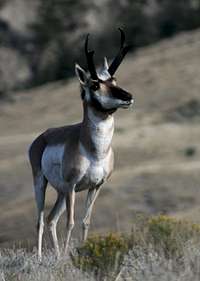


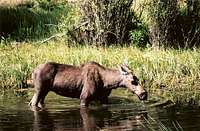

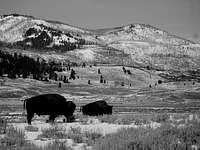
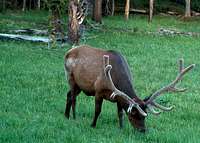
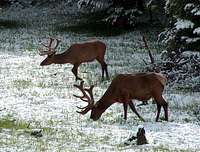







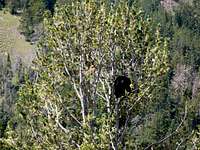
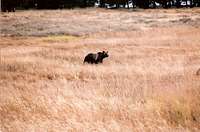
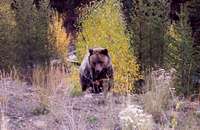

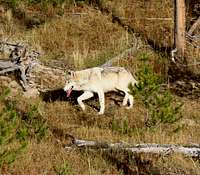
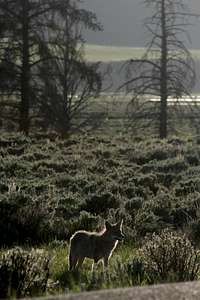
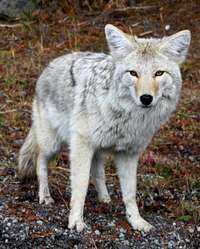

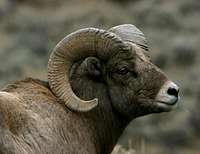

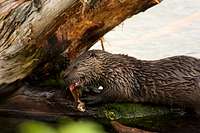








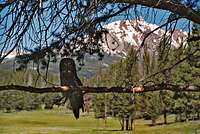





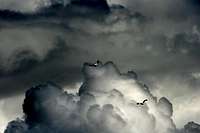

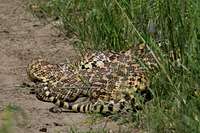

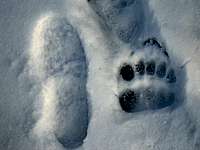










Comments
Post a Comment